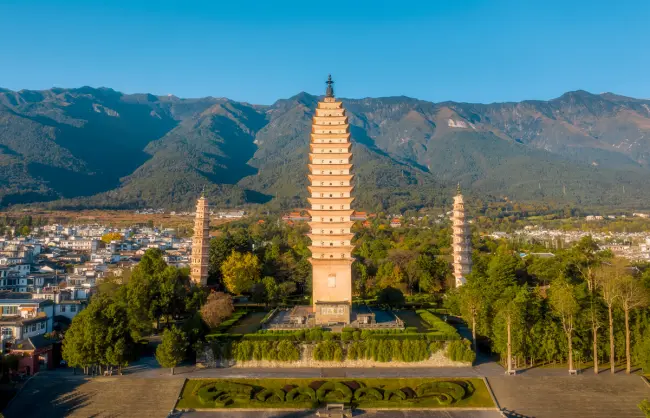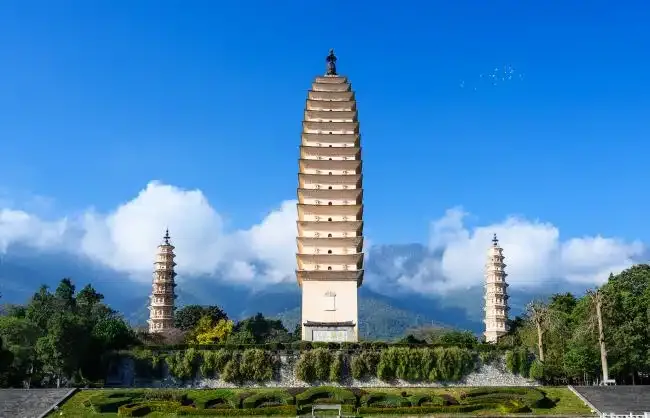Located about 1.5 kilometers northwest of Dali Ancient Town, the Three Pagodas of Chongsheng Temple was once one of the five great treasures of Chongsheng Temple. Now, it is the only surviving treasure of the temple, having stood in an isosceles triangle arrangement between the Cangshan Mountains and Erhai Lake for over 1,200 years.
During the Nanzhao Kingdom and Dali Kingdom, Buddhism is extremely flourishing in this region. The Three Pagoda of Chongsheng Temple was thus ordered to be constructed, making them witnesses to the development of Buddhism in the area. Today, these three pagodas have become an important cultural symbol and iconic landmark of Dali. Its eye-catching formation, exquisite craftsmanship, and rich culture and history have attracted worldwide visitors to travel to Dali.
Fast Facts of the Three Pagodas
- Chinese name: 崇圣寺三塔 (Chongsheng Si Santa)
- Location: National Highway 214, Dali Bai Autonomous Prefecture, Dali City; in the northern suburbs of Dali Ancient City, at the eastern foothills of Cangshan Mountains.
- Opening hours: 7:10-19:00 from May to 7th October; 7:30-18:30 from 8th October to April the next year.
- Tickets: CNY 120 per person (battery car is not included)
- Why visit: One of the symbols of the rich historical and cultural heritage in Dali; the unique architectural style and exquisite carvings and paintings; beautiful natural environment.
- Visiting time needed: around 3 hours
- Best time to visit: All year round, March to April is especially recommended.
History around Dali Three Pagodas and Chongsheng Temple
Since the Nanzhao Kingdom, the seed of Buddhism has been flourishing in Dali. Over 3,800 temples of different sizes are scattered among this region at its peak. According to the record, most people of Dali, regardless of their wealth and ages, are deeply devoted to Buddhism at that time, since they are closer to India.
To the 10th king of the Nanzhao Kingdom (824–859 AD), the expansive Chongsheng Temple complex was ordered to be constructed. The iconic Qianxun Pagoda and the smaller North and South Pagodas were also included in the temple complex. Besides these three pagodas, the Chongsheng Temple also boasts seven towers, nine halls, over 890 rooms, and 11,400 Buddha statues. The temple then served as the spiritual center of the Nanzhao and Dali Kingdoms. And to some degree, it is also a royal temple where nine emperors abdicated to become monks there.

Due to various reasons, many treasures of Chongsheng Temple have been lost. And the temple itself was destroyed by an earthquake in the Qing Dynasty. The Three Pagodas were the only treasure that still stood resiliently after undergoing over 30 earthquakes over the past thousand years.
In 1978, local cultural relic workers uncovered over 680 precious artifacts from the Nanzhao and Dali Kingdoms on the pagodas. These artifacts include metalwork, crafts, jewelry, and medicinal herbs, providing valuable insights for studying the cultural and religious art of the Tang and Song Dynasties. Some of them have been displayed in the Yunnan Provincial Museum now.
What to See around the Three Pagodas and Chongsheng Temple
Three Pagodas – Unique Architectural Features
The Three Pagodas of Chongsheng Temple are arranged in a tripod formation, showing a magnificent view from afar. Qianxun Pagoda is the main pagoda, standing 69.13 meters at the front. Flanking the main pagoda are two smaller north and south pagodas standing about 42.19 meters tall. All these pagodas overlook Erhai Lake to the east and have the Cangshan Mountains as background.
The main pagoda is a hollow brick pagoda in a square shape, with dense eaves neatly arranged on each of its 16 stories. Its pagoda body is straight and upright, presenting clear lines and a dignified appearance. When observing at a close distance, exquisite relief carvings and Buddha Statues in the niches can be seen on the pagoda body, reflecting the rich cultural heritage of Buddhism.
Both of the two flanked pagodas are 42.19 meters high, with ten stories. They are also hollow pagodas with dense eaves but in an octagonal shape. The pagoda bodies are adorned with floral patterns and Buddha images.
Chongsheng Temple
The Chongsheng Temple was once a major venue for important Buddhist activities during the Nanzhao and Dali Kingdoms. Then, in the Qing Dynasty, warfare and natural disasters destroyed the temple, with only the Three Pagodas surviving. To restore the temple to its former glory, a reconstruction was carried out in 2004. Behind the Three Pagodas, multiple ancient buildings were rebuilt, Preserving their historical charms.
Main attractions in the Chongsheng Temple include Mahavira Hall which houses a statue of Shakyamuni Buddha and many exquisite murals telling Buddhist stories. The Rain Copper Guanyin statue enshrined in the Rain Copper Guanyin Hall is a typical representation of the Guangyin style in the Nanzhao Kingdom. The Golden Wing Bird statue on the Dapeng Golden Wing Bird Plaza is a notable landmark of Chongsheng Temple. The Nanzhao Jianji Great Bell boasts the biggest bell in Yunnan…
With a building area of 20,080 square meters, the entire scenic area has many more halls, corridors, and pavilions thoughtfully arranged on its three main axes.
Reflection Park of the Three Pagodas
About 1 kilometer south of Dali Three Pagodas Park, the park got its name for the reflection of the Three Pagodas in its Reflection Pond. The central pond spans over 10 acres, in an oval-shape. Its crystal clear water allows visitors to see the reflection of the Three Pagodas clearly. The park thus becomes a must-visit site for photography enthusiasts to capture the Three Pagodas and their reflections at the same time.
Recommended Yunnan Tours including Dali Three Pagodas:
- 3-Day Dali Tour with Memorable Experience
- 4 Days Dali Essence Tour
- 8 Days Classic Yunnan Minority Tour of Kunming-Dali-Lijiang-Shangri-La
Photography Tips for the Three Pagodas in Dali
- Taking photos in the morning is recommended for the higher brightness and purity of the morning light.
- Recommended photography spots include: The Reflection Park is ideal for taking in the reflections of the pagodas; The plaza in front of the Three Pagodas offers a great point to capture the entire pagodas; Wanghai Tower, the highest building in the temple complex, offers panoramic views of the Three Pagodas with the surrounding Cangshan Mountain and Erhai Lake.

Dali Three Pagodas in Chongshen Monastery
How to Get to and Travel Around
From Dali Ancient Town: The Three Pagodas Park is just a stone’s thrown away from the ancient town. Visitors can take a taxi or Bus No. 19 from the North Gate of the ancient town to the 3 Pagodas in a few minutes. Or, you can walk to the 3 Pagodas in about 20 minutes.
From Dali Railway Station: Both taxis and direct shuttle buses are available to reach the 3 pagodas.
From Dali Airport: You can take the shuttle bus to reach Dali Ancient Town first. Then, take a bus, walk or taxi to reach the pagodas.
Travel around: The Chongsheng Temple Scenic Area is expansive and includes many attractions. Electric shuttle service is a good choice to conserve energy, both round-trip and one-way rides are available. The main boarding points include the park entrance, Chongsheng Temple Gate, and Daxiong Hall of Chongsheng Temple, and the Three Pagodas. If you prefer walking, you can also explore the park on foot. The full route is about 7 kilometers and will take about 3-5 hours.
Best Time to Visit
The Three Pagodas and Chongsheng Temple is good to visit all year round. The average annual temperature is around 15°C in Dali.
March to April is especially recommended for multiple festivals and events are took place in this period. The Bai ethnic festivals, such as March Street Festival from 15th to the 21st days of the third lunar month, Butterfly Festival on the 15th day of the fourth lunar month will offer you a rich cultural experience.
Attractions Nearby
- Dali Ancient Town: About 1.5 kilometers from the 3 pagodas; Is known for its Bai ethnic residences, time-honored landmarks, and rich culture.
- Cangshan Mountains: About 2 kilometers from Dali 3 Pagodas; It is a magnificent mountain range consisting of 19 peaks; An ideal place for hiking and photography.
- Erhai Lake:About 17 kilometers from Dali Three Pagodas; It is a vast fresh lake in an ear shape, with beautiful natural surroundings; Many ancient villages and towns along its shores offer great chances to experience Bai culture.









